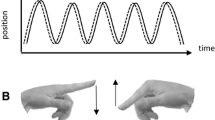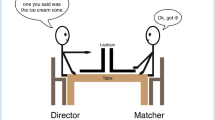Abstract
Autistic children were compared with chronological and mental agematched normal children on two tests of motor imitation and on the Herzig Battery for Non-Focal Neurological Signs. The results indicated that autistic children have significant handicaps in the neurodevelopmental area, with very poor performance on motor imitation tasks and a universal and significant excess of soft signs of neurological dysfunction. Such “dyspraxias” may underlie the failure of these chlidren to learn to use gesture.
Similar content being viewed by others
References
American Psychiatric Association (1980).Diagnostic and statistical manual of mental disorders (3rd ed.). Washington, DC: Author.
Bartak, L., Rutter, M., & Cox, A. (1975). A comparative study of infantile autism and specific developmental receptive language disorder. I.British Journal of Psychiatry, 126, 127–145.
Berges, J., & Lezine, I. (1965).The imitation of gestures. Suffolk: Lavenham Press.
DeMyer, M. (1972). The nature of the neuropsychological disability in autistic children.Journal of Autism and Childhood Schizophrenia, 2, 264–287.
DeMyer, M., Alpern, G., Barton, S., DeMyer, M., Churchill, D., Hingtgen, J., Bryson, C., Pontius, W., & Kimberlin, C. (1972). Imitation in autistic, early schizophrenic, and nonpsychotic subnormal children.Journal of Autism and Childhood Schizophrenia, 2, 264–287.
DeMyer, M., Barton, S., Norton, J. (1972). A comparison of adaptive, verbal and motor profiles of psychotic and nonpsychotic subnormal children.Journal of Autism and Childhood Schizophrenia, 2, 359–377.
DeMyer, M., Hingtgen, J., & Jackson, R. (1981). Infantile autism reviewed: A decade of research.Schizophrenia Bulletin, 7, 388–451.
Hammes, J., & Langdell, T. (1981). Precursors of symbol formation and childhood autism.Journal of Autism and Developmental Disorders, 11, 331–346.
Hertzig, M. E. (1981). Neurological soft signs in low birth weight children.Developmental Medicine and Child Neurology, 23, 778–791.
Hertzig, M. E. (1982). Stability and change in non-focal neurological signs.Journal of the American Academy of Child Psychiatry, 21(3), 231–236.
Hertzig, M. E., Bortner, M., & Birch, H. G. (1969). Neurologic findings in children educationally designated as “brain-damaged”.American Journal of Orthopsychiatry, 39, 437–446.
Prior, M. R. (1977). Psycholinguistic disabilities of autistic and retarded children.Journal of Mental Deficiency Research, 21, 37–45.
Prior, M. R. (1979). Learning abilities and disabilities in childhood autism: A review.Journal of Abnormal Child Psychology, 7, 357–380.
Prior, M. R. (1984). Development concepts of childhood autism: The influence of experimental cognitive research.Journal of Consulting and Clinical Psychology, 52, 4–16.
Ricks, D. M.,&Wing, L. (1975). Language, communication, and the use of symbols in normal and autistic children.Journal of Autism and Childhood Schizophrenia, 5, 191–222.
Rutter, M. (1974). The development of infantile autism.Psychological Medicine, 4, 147–163.
Rutter, M. (1977). Brain damage syndromes in childhood: Concepts and findings.Journal of Child Psychology and Psychiatry, 18, 1–21.
Rutter, M. (1982). Syndromes of minimal brain dysfunction in childhood.American Journal of psychiatry, 139, 21–33.
Tubbs, V. K. (1966). Types of linguistic disability in psychotic children.Journal of Mental Deficiency Research, 10, 230–240.
Van Smeerdijk, L.(1981). Childhood autism and the problem of imitation. Unpublished honors thesis, La Trobe University, Victoria.
Wing, L. (1969). The handicaps of autistic children — A comparative study.Journal of Child Psychology and Psychiatry, 10, 1–40.
Wing, L. (EDd.). (1976).Early childhood autism (p. 21). Oxford: Pergamon Press.
Author information
Authors and Affiliations
Rights and permissions
About this article
Cite this article
Jones, V., Prior, M. Motor imitation abilities and neurological signs in autistic children. J Autism Dev Disord 15, 37–46 (1985). https://doi.org/10.1007/BF01837897
Issue Date:
DOI: https://doi.org/10.1007/BF01837897




